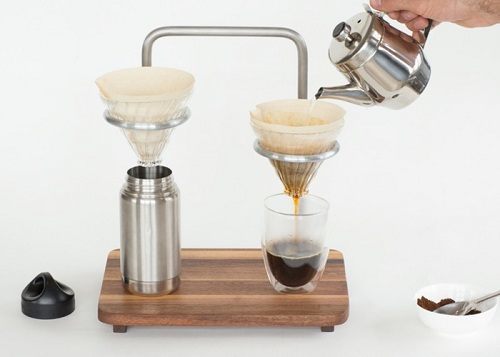There are so many different coffee brewing methods out there and each one offers its own perks. Each one also has its strong group of avid supporters who insist it is the best way to brew coffee or even the only way to brew coffee.
In our opinion, there is no single best method. It’s actually better to have a variety of different methods available to suit the occasion. Each method has its advantages and its time to shine. So let’s take a look at some of the most popular ways to brew coffee.
Drip Coffee Maker
This is your standard coffee machine. You have probably seen one and even used one. There are many different models, each with different features, but the basic idea is: add coffee. Add water. Push button. Wait.
Some are programmable so that they can automatically start brewing before you wake up. Some have coffee grinders built in so even that can be automated. Essentially, the different models are just different degrees of convenience.

Typically, you should be using a medium to medium-fine grind for most of these machines (espresso machines are an obvious exception).
The key advantage that these have is convenience and minimal effort. You can just push a button (or program it) and walk away. When you come back, coffee is waiting for you. This is great if you absolute cannot spare an extra 15 minutes or so to brew your coffee by hand.
In fact, we find that it’s best to have at least a simple drip coffee maker on hand for those occasional (but inevitable) late mornings when you don’t have the time to do your normal coffee brewing ritual.
It’s a great and reliable friend in such emergencies. But for a cup of coffee that tastes of perfection, you’ll want a more hands on method like those below, one that allows you to control the brew more precisely.
Pour Over Coffee Brewer
The pour over method has been around for a while and it is probably our favorite method just in terms of the resulting brew and the beautiful ritual that is involved. The basic steps are as follows:

- Heat water.
- Grind beans. Aim for something between medium and fine (something between sand and granulated sugar). You have a little wiggle room here to find your preferred grind.
- Add grounds to filter. Shake gently to even out the bed.
- Pour about 10% of the water over the grounds, directly into the center to wet them.
- Let “bloom” (swell) for about 30 seconds or until it stops.
- Pour the remaining water in a slow, constant flow. Don’t just pour into the middle. Work your way over the coffee in concentric circles to evenly soak all the grounds. Do this slow enough to last about 3 minutes (if making 1 liter).
- Let dripping continue for another minute or so.
- Serve
Coffee brewing temperature is important. There is no fixed perfect temperature, but generally the pour over method uses something between 175 and 205 degrees Fahrenheit. Play around with temperatures in that range until you land on the temperature that gives you the flavor you are looking for.
This has a bit of a learning curve in terms of technique, especially when it comes to the pour. But there’s a lot of specialized equipment available to help make it a little easier. The best thing about this method is that you have complete control over the brew.
That’s why technique is so important. When you do something wrong, it shows up in the end result. But that also means that tasting your brew is an opportunity to learn what you might need to do differently next brew.
This means that you are not just mimicking a recipe or technique you read on the internet, but actually learning the meaning and importance of each part of the process so that you can become a master of your perfect brew.
French Press Coffee Maker
The French press is one of the most elegant ways to brew a cup of coffee. It’s also a fairly simple technique:

- Heat water. 200 Fahrenheit is generally considered the ideal temperature for a French press.
- Grind coffee, coarsely. It should be about the texture of sea salt or raw sugar.
- Add grounds to the French press.
- Add hot water. Swirl gently to combine.
- Let mellow for 2-4 minutes. The longer you steep, the more robust the brew so tweak the timing to your own preference.
- Press down the plunger.
- Serve.
The French press can really highlight the important relationship between coffee beans and brew. Too fine a grind here, and you are going to end up with a bitter disaster. And if you try to use pre-ground coffee, you’ll end up with something you should only drink if you are absolutely desperate.
As long as you take care that you have the right temperature and the right grind, your French press brew is going to taste wonderful. Many who complain that French press coffee is too bitter or murky are actually revealing that they ground the beans to finely (and/or heated the water above 200).
If you want to take your French press to the next level, warm the chamber before you add your ingredients. You can do this simply by pouring in a little hot water, swirling it around and dumping it just before you add your grounds and water.
Warming it creates a better environment for brewing by decreasing the temperature difference between the cold glass and the hot water.
Another special note on the French press: don’t let your coffee sit in the press after the brew time is up. If you don’t plan to drink all of it immediately, pour it into a glass decanter (a pour over carafe or regular coffee pot are perfect).

Otherwise, the grounds will continue steeping, transforming your once perfect brew into a bitter, muddy mess.
Our favorite things about the French press include:
- Great coffee: as long as you pay attention to the details, the technique itself is actually really easy.
- Easy to learn. As stated, it won’t taste good if you don’t get the temperature or grind right, but it’s not hard to do. Heating water and grinding coffee are very simple.
- Easy clean up: the cylinder shape of the chamber along with the smooth glass interior make this beauty very easy to clean.
- Beautiful: even while not in use, a French press just looks so lovely as a piece on the counter. It takes up very little space and has an understated elegance in its design.
- Portable: you can easily take your French press with you on the move. Get a hand burr grinder to go with it and you can have coffee brewed to perfection even while you’re roughing it.
The French press is a great place to start before you head into pour over coffee territory. It’s a great transition for those who have been relying on a machine for as long as they’ve been drinking coffee and want to branch out.
Although you might have a few bitter cups while you work out the grind size (unless you have a grinder with programmable settings) at first, you will be able to quickly work out the kinks and realize what you have been missing all these years.
Once you master a French press, move up to the pour over method to improve your skill and your brew even more.
Cold Brew Coffee
Cold brew is not the same as iced coffee. It doesn’t use ice and the water is never heated at any point. The technique for how to brew cold coffee is actually pretty simple:
- Grind your coffee very coarsely, at least as coarse as French press grind but it can be coarser.
- Place the grounds in your container. If you are using a specialized cold brew coffee maker, there will be a section for the grounds. If you are using a French press, just put them where you normally would.
- Add cold, filtered water.
- Let soak for 18-24 hours.
- Serve
This method allows for a very slow diffusion process which releases all of those wonderful floral aromas and results in a sweeter, less acidic cup of coffee. It does not taste like old, stale coffee that has gone cold. And it does not risk becoming too watery like iced coffee.

It’s precisely the perfect brew for a hot summer morning when you want to feel refreshed and still get that early morning boost.
What’s even better is that, unlike the pour over iced coffee method discussed above, cold brew coffee takes minimal effort. Just throw it all together the day before and voila! The next morning, a refreshing cup of cold brew is waiting for you.
It can stay fresh and flavorful for up to a week if kept in the fridge so you can make a large batch of it on Sunday to keep you going through the work week. Or have a batch ready and waiting for a surprise visit from friends.
As you can see, each method has its own special quality to it. If you master all of them, you will be able to make the perfect cup of coffee for every occasion.

